Listen Deeper: Unlock True Connection by Understanding the Unmet Need Behind the Words
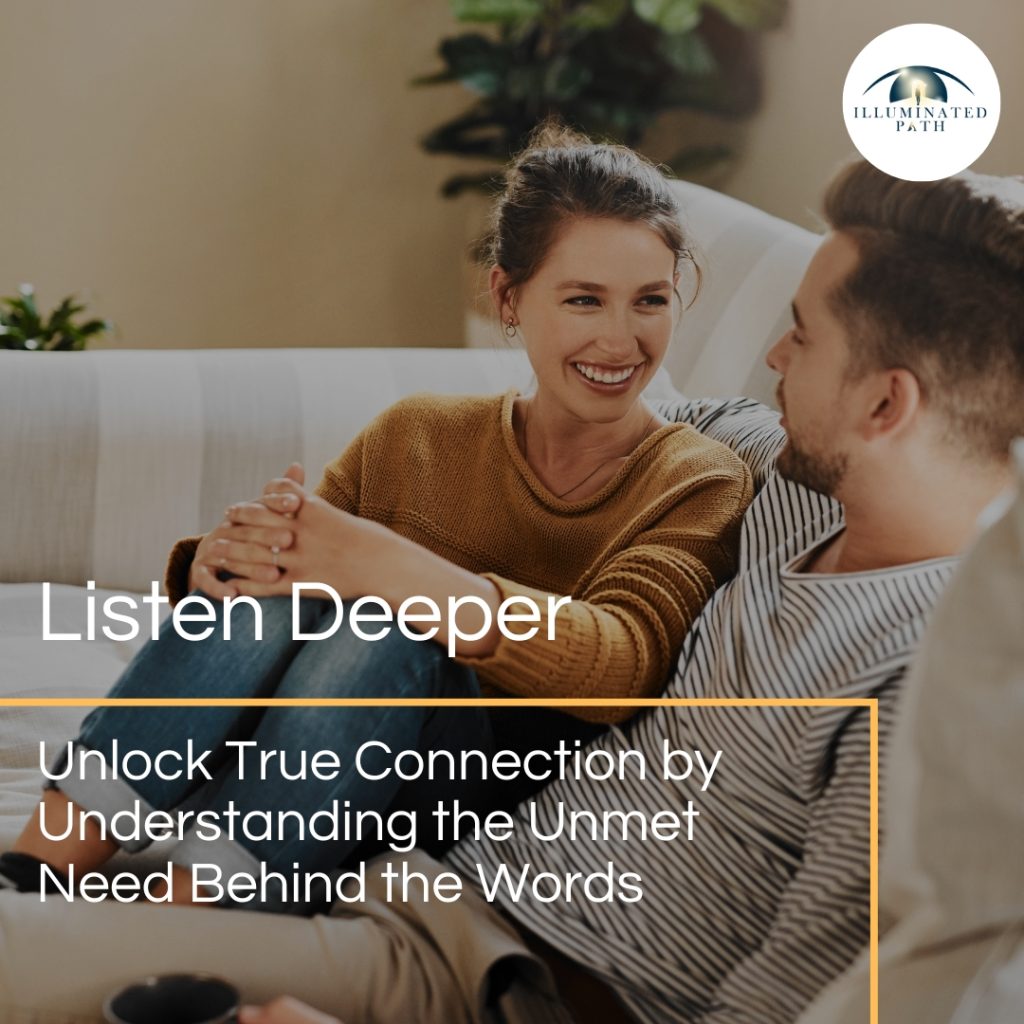
“Listen not to reply, but to understand the unmet need behind the words.” This simple yet profound quote holds the key to transforming the way we connect with others. In everyday conversation, most of us are caught up in formulating responses even before the other person finishes speaking. We hear the words—but often, we miss what’s really being said. The emotional truth. The unspoken need. And that’s where the real magic of connection lives. Listening, at its deepest level, is not about collecting facts. It’s about tuning into the human experience behind the words. And when we do this—when we truly listen with empathy—we unlock deeper trust, melt away resentment, and lay the foundation for authentic, lasting relationships. From Hearing to Listening: The Shift That Changes Everything Let’s begin with a truth that’s easy to overlook: hearing is automatic; listening is intentional. Hearing happens without effort. It’s passive. We hear the hum of traffic or the clatter of dishes in the next room. But listening—that requires presence. Attention. Curiosity. Deep listening is an act of compassion. It’s about silencing the mental chatter and stepping into someone else’s emotional landscape. This kind of listening doesn’t come naturally in our distracted, fast-paced world. But it’s learnable. And it’s worth every ounce of effort. When we shift from simply hearing someone’s words to truly understanding what they’re trying to express—even if they’re not saying it perfectly—we become a safe space for others. That’s when real connection begins. Why People Say What They Say: The Role of Unmet Needs Every word spoken in conflict, every complaint or criticism, every emotional withdrawal, is often a symptom of something deeper: an unmet need. A need for respect. A need to feel seen. A need to belong, to be understood, to matter. When someone says, “You never listen to me,” what they may really mean is: “I feel invisible.” When someone snaps, “You always make it about you,” it might be: “I’m craving space to share what I’m going through.” We often argue at the surface level—about chores, time, tone, who’s right and who’s wrong. But underneath these arguments, if we’re willing to listen deeper, are feelings of fear, loneliness, shame, or pain waiting to be heard. Understanding this changes everything. Instead of reacting defensively, we can respond with empathy. Instead of escalating tension, we can move toward resolution and intimacy. The challenge is learning how to recognize these hidden emotional currents. Empathy Is Not Just a Feeling—It’s an Action Empathy is frequently misunderstood. It’s not just “feeling sorry” for someone. It’s not passive. True empathy is active. It’s the deliberate act of seeing and feeling the world through someone else’s eyes—and then showing them that they’re not alone. Empathetic listening is the primary way we express this action. It starts with presence—being fully here. That means putting down your phone, making eye contact, softening your body language, and turning toward the person as if to say, “I’m here. I’m listening. You matter.” It continues with restraint—resisting the urge to interrupt, fix, judge, or compare. Letting the speaker have their space. Trusting that being heard is often more healing than being advised. And it ends with validation—not necessarily agreement, but acknowledgment. Saying things like, “That sounds really difficult,” or “I can see why you’d feel that way,” is incredibly powerful. It says, “I get you.” That validation is often what people are truly seeking when they open up. How to Practice Deep, Empathetic Listening Like any skill, empathetic listening improves with practice. Here are several techniques to help develop it—not as a checklist, but as a mindset shift. Start with intention. Before you enter a conversation, especially one that might be emotionally charged, remind yourself why you’re listening. Is it to understand, or to win? Is it to connect, or to correct? Your intention will shape your attention. Be fully present. This means giving the speaker your full attention. That’s not just about hearing their words; it’s about tuning in to their tone, their body language, the pauses between their sentences. Often, what’s not said speaks volumes. Pause before responding. We tend to rush in with our own stories or solutions. Instead, let their words settle. A short pause gives both of you space and communicates that you’re taking what they said seriously. Reflect what you hear. This might sound like: “So what I’m hearing is…” or “It sounds like you’re feeling…” This not only shows that you’re engaged—it helps the speaker feel seen and can even clarify things for them. Ask questions—not to probe, but to understand. For example: “What do you need most right now?” or “How long have you been feeling this way?” These kinds of questions invite deeper connection. Validate their emotions. Even if you don’t agree with the logic, you can validate the feeling. “I understand why that would be upsetting,” goes a long way in disarming conflict and building trust. Common Obstacles—and How to Move Through Them Of course, listening deeply isn’t always easy. Sometimes our own emotions or patterns get in the way. Here are a few common roadblocks, and ways to overcome them: 1. You’re triggered.Maybe something they said hit a nerve. You feel yourself tense up, maybe even want to lash out. In this moment, the most compassionate thing you can do—for both of you—is to pause and breathe. If needed, ask for a short break before continuing. Regulation is key to connection. 2. You’re distracted.We all have busy minds and busy lives. But multitasking while someone is sharing something important sends the message that they—and their emotions—are not a priority. Even setting aside five undistracted minutes can completely shift the dynamic. 3. You’re unsure what to say.It’s okay not to have the perfect response. Often, simply saying “Thank you for sharing that with me,” or “I’m here for you,” is enough. Silence, when held with care, is its own form of empathy. Why This Matters in Real Life Empathetic listening isn’t just a nice idea for
True Intimacy: The Power of Being Fully Seen Without Fear of Judgment.
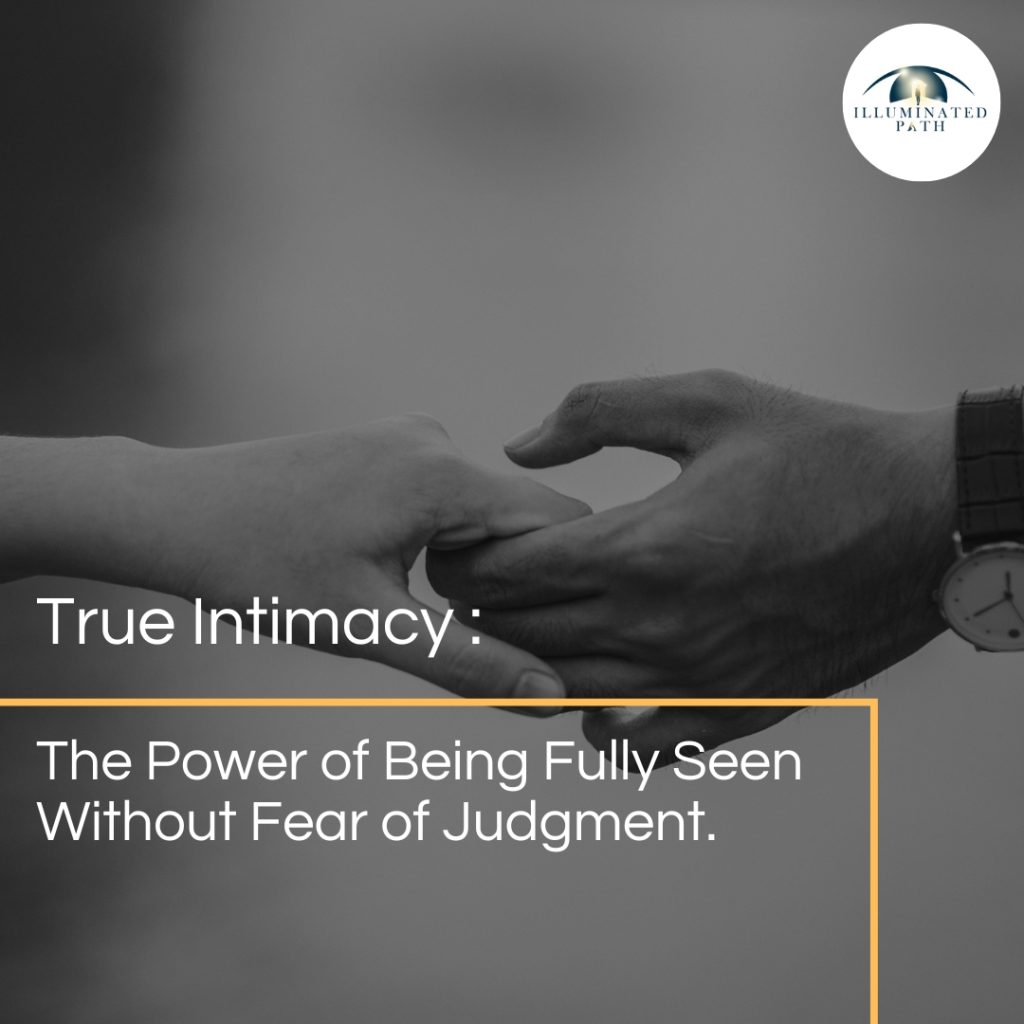
True intimacy begins where performance ends. It’s not about perfection or constant agreement. It’s about two people showing up authentically—vulnerabilities, fears, and all—without the fear of judgment. This kind of connection is rare, but it’s also the most rewarding. What Is True Intimacy? (And What It’s Not) Intimacy is often confused with physical closeness or romantic gestures. But true intimacy is emotional and psychological. It’s the deep sense of closeness that comes from mutual openness, trust, and emotional safety. True intimacy is: Being able to share your deepest thoughts and feelings without fear Feeling emotionally safe and accepted Being seen and loved for your authentic self True intimacy is not: Constant agreement or avoiding conflict Performing or pretending to be someone you’re not Relying solely on physical closeness without emotional connection As noted by Psychology Today, emotional intimacy is the glue that holds relationships together, enabling individuals to express their true selves without fear of judgment or rejection . Why Vulnerability Is the Gateway to Connection Dr. Brené Brown, a leading researcher on vulnerability, says: “Vulnerability is the birthplace of love, belonging, joy, courage, empathy, and creativity.” the outcome. It’s the willingness to say, “This is me,” even when we fear rejection. When both partners embrace vulnerability, they create a space where true intimacy can flourish. It allows for deeper understanding, empathy, and connection . The Fear of Judgment: Intimacy’s Greatest Barrier Many people avoid vulnerability because they fear judgment or rejection. This fear can prevent partners from sharing their true feelings and experiences, leading to a lack of emotional connection . Common fears include: “If I show my true self, they won’t love me.” “If I express my needs, I’ll seem needy or weak.” “If I reveal my past, they’ll judge me.” These fears can lead to emotional walls, preventing genuine connection. But hiding your true thoughts and needs erodes trust because genuine intimacy requires openness . How to Cultivate True Intimacy in Your Relationship Building true intimacy requires intentional effort and mutual commitment. Here are practical steps to deepen your connection: 1. Practice Radical Honesty Share your thoughts and feelings openly, even when it’s uncomfortable. Honesty fosters trust and allows your partner to understand your inner world. 2. Create a Judgment-Free Zone Encourage open dialogue without criticism or defensiveness. Listen actively and validate your partner’s experiences. 3. Share What Scares You Discuss your fears and insecurities. This vulnerability can lead to deeper empathy and connection. 4. Make Space for Each Other’s Inner World Be curious about your partner’s thoughts and feelings. Ask open-ended questions and show genuine interest. 5. Build Trust Through Consistency and Care Follow through on promises and be reliable. Consistent actions build a foundation of trust. By prioritizing emotional intimacy, you create a solid foundation for a fulfilling and lasting partnership . The Payoff: Why True Intimacy Is Worth the Risk Embracing vulnerability and cultivating true intimacy can lead to: Greater Relationship Satisfaction: Couples who share openly experience deeper connection and fulfillment. Enhanced Emotional Resilience: Facing challenges together strengthens the bond and builds resilience. Increased Trust and Security: Consistent honesty and openness foster a safe and trusting environment. Emotional intimacy is the glue that holds relationships together, enabling individuals to express their true selves without fear of judgment or rejection . Final Thoughts: Choose Vulnerability Over Performance True intimacy requires courage—the courage to be seen, to be vulnerable, and to risk rejection. But the reward is profound: a deep, authentic connection where both partners feel valued, understood, and loved. Reflect on your relationships: Are you showing up authentically? Are you creating a safe space for your partner to do the same? Embrace vulnerability. Let go of the fear of judgment. And experience the transformative power of true intimacy. The Author Dr. Shadi Souferian Psy. D. Licensed Clinical Psychologist Therapist And Psychologist in Los Angeles And Beverly Hills. You might also enjoy this article: True Intimacy: The Power of Being Fully Seen Without Fear of Judgment. April 19, 2025Relationship True intimacy begins where performance ends. It’s not about perfection or constant agreement. It’s about…Read more How Resilience Helps Us Overcome Stress: Adapt, Don’t Avoid April 15, 2025Personal Development Introduction: Why Resilience Matters Now More Than Ever Whether it’s the pressure of deadlines, a…Read more Beyond Words: Why True Empathic Listening is the Cornerstone of a Powerful Relationship March 26, 2025Relationship In the intricate dance of human connection, particularly within the intimate sphere of a romantic…Read more When the Smoke Detector Never Stops Beeping: Understanding and Addressing Chronic Anxiety March 18, 2025Personal DevelopmentTrauma Daniel Goleman, the renowned expert on emotional intelligence, offered a potent analogy for understanding anxiety:…Read more The Silent Crisis: Parental Burnout and Hidden Stress in Modern Families March 11, 2025Parenting Modern parenting is often depicted as a journey filled with immense joy and profound love,…Read more Designing a Healing Space: How Environment Impacts Mental Health March 4, 2025Therapy Room The spaces we inhabit are not passive backdrops to our lives—they actively shape our emotions,…Read more
Beyond Words: Why True Empathic Listening is the Cornerstone of a Powerful Relationship
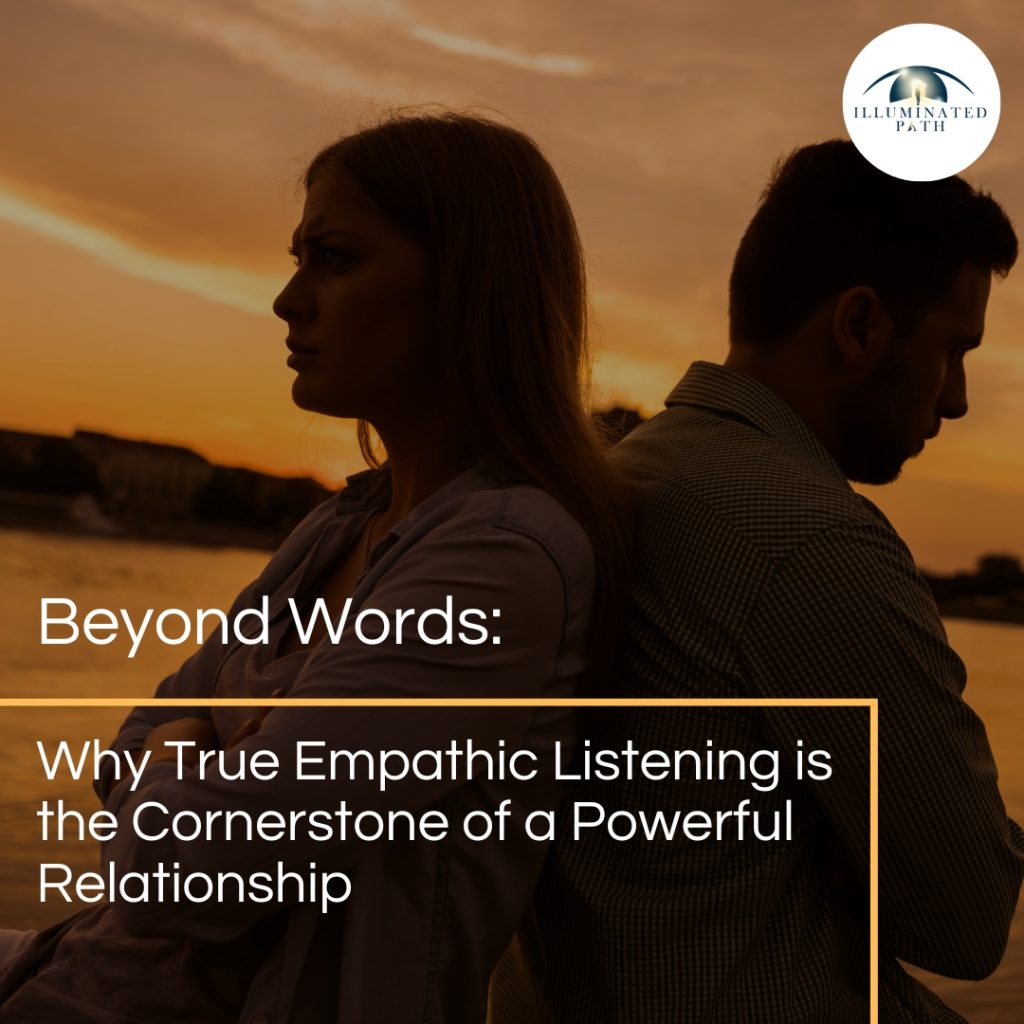
In the intricate dance of human connection, particularly within the intimate sphere of a romantic partnership, we often place immense value on the power of communication. We strive to articulate our needs, share our joys, and express our vulnerabilities through carefully chosen words. We engage in debates, navigate disagreements, and attempt to bridge the gaps in understanding through the verbal exchange of thoughts and feelings. And yet, amidst this focus on speaking, a far more profound and often overlooked skill lies waiting to unlock the true potential of our relationships: true empathic listening. It’s a concept often paid lip service to, a bullet point in relationship advice articles, but rarely explored in its full depth and transformative power. We might believe we are good listeners, nodding along, offering occasional interjections, and waiting for our turn to speak. However, genuine empathic listening transcends mere hearing; it delves into the emotional landscape of our partner, seeking to understand not just the words being spoken, but the unspoken feelings, the underlying needs, and the unique perspective that shapes their experience. It is not simply about absorbing information; it is about actively engaging with another human being on a profound emotional level, creating a safe and validating space where true connection can flourish. We will explore what it truly means to listen with empathy, differentiate it from other forms of listening, and unpack the myriad benefits it brings to a partnership, ultimately demonstrating why it is often the silence, filled with understanding, that speaks volumes in the language of love. The Illusion of Listening: Decoding Different Listening Styles Before we can truly appreciate the power of empathic listening, it’s crucial to recognize the various ways we often engage in what we perceive as listening, and how these fall short of genuine empathy. Passive Listening: This is perhaps the most basic form, where we are physically present but our minds may be elsewhere. We might hear the words, but we are not actively processing them, nor are we attuned to the emotional undertones. It’s akin to background noise, failing to create any real connection. Selective Listening: In this mode, we tune in only to the parts of the conversation that interest us or align with our own agenda. We might filter out information that challenges our beliefs or requires us to step outside our comfort zone, missing crucial aspects of our partner’s experience. Competitive Listening: This style is characterized by a focus on waiting for our turn to speak, often formulating our response while our partner is still talking. The primary goal is to share our own thoughts or opinions, rather than truly understanding the other person’s perspective. Conversations become a battle for airtime, hindering genuine connection. Attentive Listening: This is a step closer to empathic listening, involving paying attention to the words being spoken, making eye contact, and offering verbal cues like “uh-huh” or “I see.” While demonstrating engagement, it may still lack the deeper emotional connection that defines empathy. True Empathic Listening: Stepping into Your Partner’s Shoes True empathic listening goes beyond these superficial forms of engagement. It is a conscious and intentional act of fully immersing ourselves in our partner’s experience, striving to understand their world as they perceive it. It involves several key components: Active Focus: Empathic listening demands our complete attention, both mentally and physically. This means minimizing distractions, putting aside our own thoughts and judgments, and being fully present in the moment with our partner. It requires a conscious effort to quiet our internal monologue and direct our energy towards understanding them. Emotional Attunement: It’s not enough to simply hear the words; we must also be attuned to the emotions underlying them. This involves observing their body language, tone of voice, and facial expressions to gain a deeper understanding of how they are feeling. It requires us to tap into our own capacity for empathy and imagine what it might be like to be in their situation. Perspective Taking: Empathic listening necessitates a genuine attempt to see the situation from our partner’s point of view, even if we don’t necessarily agree with it. This involves suspending our own biases and assumptions and trying to understand their motivations, fears, and desires. It’s about acknowledging the validity of their experience, even if it differs from our own. Validation: A crucial aspect of empathic listening is validating our partner’s feelings. This doesn’t mean we have to agree with their perspective or condone their actions, but it does mean acknowledging that their emotions are real and important. Phrases like “That sounds really frustrating” or “I can see why you would feel that way” can create a sense of being heard and understood, fostering emotional safety. Reflecting and Clarifying: To ensure we are truly understanding our partner, empathic listening involves reflecting back what we have heard, both in terms of content and emotion. This might involve paraphrasing their words or summarizing their feelings to confirm our understanding. Asking clarifying questions demonstrates our genuine interest and allows our partner to elaborate further. Non-Judgmental Presence: Empathic listening requires us to approach our partner without judgment or criticism. When we feel judged, we are less likely to open up and share our true selves. Creating a non-judgmental space allows for vulnerability and fosters a deeper sense of trust and intimacy. The Transformative Power of Empathic Listening in Relationships When true empathic listening becomes a consistent practice within a relationship, its impact is profound and far-reaching: Deepened Emotional Connection: By truly hearing and understanding our partner’s inner world, we forge a deeper emotional bond. It creates a sense of being seen, understood, and valued, which are fundamental needs in any intimate relationship. This emotional connection acts as a strong foundation, weathering the inevitable storms of life. Enhanced Trust and Security: When we consistently feel heard and validated by our partner, it builds a strong sense of trust and security within the relationship. Knowing that our feelings and experiences
Finding the Way Back to Connection: How Therapy Fosters Deeper Relationships With Self and Others
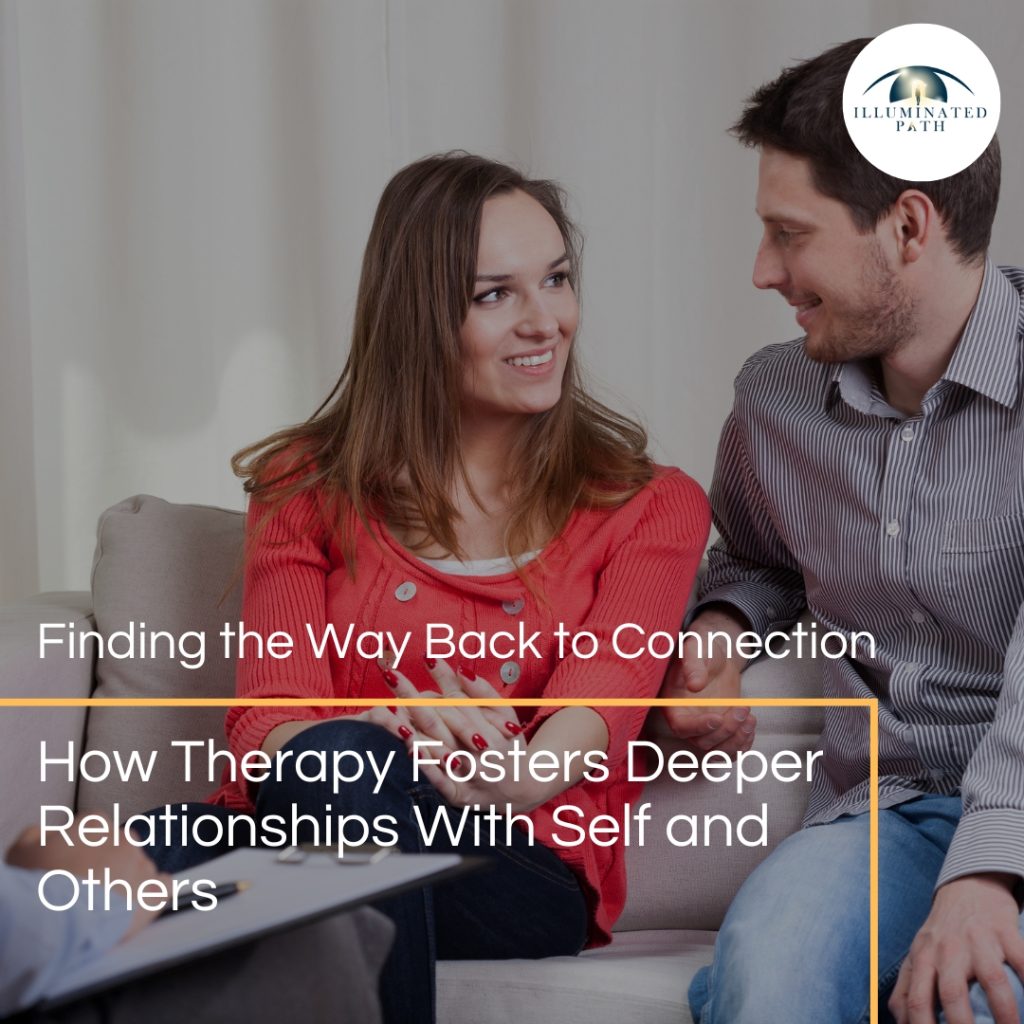
“In therapy, we are trying to help people feel more connected to themselves and others.” – Sue Johnson This insightful quote from Dr. Sue Johnson, a renowned clinical psychologist and developer of Emotionally Focused Therapy (EFT), perfectly captures a fundamental truth about the human experience: we are wired for connection. Our brains are intricately designed to seek out and thrive in relationships, and when these connections are fractured or absent, we suffer deeply. Therapy, in its many forms, offers a pathway back to this essential connection. It provides a safe and supportive space to explore the barriers that prevent us from experiencing genuine intimacy with ourselves and others, and to develop the skills necessary to build and maintain healthy relationships. The Science of Connection The need for connection is not merely a social construct; it is deeply rooted in our biology. Research in neuroscience and attachment theory has revealed the profound impact that relationships have on our physical and mental well-being. Attachment theory, pioneered by John Bowlby and Mary Ainsworth, proposes that our early childhood experiences with caregivers shape our internal working models of relationships, influencing how we connect with others throughout our lives. Secure attachment, characterized by feelings of safety and trust, fosters emotional regulation, resilience, and healthy relationships. In contrast, insecure attachment, often stemming from early experiences of neglect or trauma, can lead to difficulties with intimacy, trust, and emotional regulation. (Source: Bowlby, J. (1969). Attachment and Loss, Vol. 1: Attachment.) Furthermore, advances in neuroscience have illuminated the neural mechanisms underlying connection. The discovery of mirror neurons, which fire both when we perform an action and when we observe someone else performing the same action, suggests that our brains are wired for empathy and understanding others. Moreover, the release of oxytocin, often referred to as the “love hormone,” during social interactions promotes feelings of trust, bonding, and well-being. (Source: Rizzolatti, G., & Craighero, L. (2004). The mirror-neuron system. Annual Review of Neuroscience, 27, 169-192.) Social psychology research consistently demonstrates the detrimental effects of social isolation and loneliness on mental and physical health. Loneliness has been linked to an increased risk of depression, anxiety, cardiovascular disease, and even premature death. Conversely, strong social connections are associated with greater happiness, resilience, and longevity. (Source: Holt-Lunstad, J., Smith, T. B., & Layton, J. B. (2010). Social relationships and mortality risk: A meta-analytic review. PLoS Medicine, 7(7), e1000316.) Disconnection: The Root of Suffering When our need for connection is unmet, or when our relationships are characterized by conflict, insecurity, or trauma, we experience a profound sense of disconnection. This disconnection can manifest in various ways, such as disconnection from self, disconnection from others, and disconnection from the world. Trauma, neglect, or societal pressures can lead to a disowning of parts of ourselves. We may disconnect from our emotions, needs, or authentic selves in an attempt to protect ourselves from pain or rejection. This can lead to feelings of emptiness, shame, and a lack of purpose. Insecure attachment, past hurts, or communication difficulties can create barriers to intimacy and connection with others. We may struggle with trust, vulnerability, or expressing our needs, leading to isolation, conflict, and unsatisfying relationships. A sense of disconnection can also extend to a feeling of alienation from the world around us. We may feel lost, hopeless, or unable to find meaning or purpose in life. This disconnection lies at the root of much human suffering, fueling depression, anxiety, addiction, and a host of other mental and physical health problems. Therapy as a Path to Reconnection Therapy, in its various forms, offers a powerful antidote to disconnection. It provides a safe and supportive space to explore and heal past wounds, develop self-awareness, improve communication skills, build trust and intimacy, cultivate self-compassion, and find meaning and purpose. Therapy can help individuals process past traumas, explore the roots of insecure attachment, and address unresolved emotional pain that may be hindering their ability to connect. It fosters greater awareness of one’s thoughts, feelings, needs, and behaviors. This increased self-understanding allows individuals to connect with their authentic selves and make choices that are aligned with their values. Therapy can also help individuals develop effective communication skills, including active listening, assertiveness, and expressing emotions in a healthy way. These skills are essential for building and maintaining healthy relationships. By identifying and overcoming barriers to trust and intimacy, such as fear of vulnerability or past betrayals, therapy can help individuals build deeper connections with others. Moreover, therapy encourages self-compassion, which involves treating oneself with kindness, understanding, and acceptance. This allows individuals to heal from past hurts and develop a more positive and loving relationship with themselves. Finally, therapy can help individuals explore their values, passions, and goals, and to find meaning and purpose in their lives. This sense of purpose can foster a deeper connection to oneself and the world around them. Different Therapeutic Approaches to Fostering Connection Different therapeutic approaches offer unique perspectives and techniques for fostering connection. Some of the most common include Emotionally Focused Therapy (EFT), Cognitive Behavioral Therapy (CBT), Psychodynamic Therapy, Mindfulness-Based Therapies, and Somatic Experiencing. EFT, developed by Sue Johnson, focuses on the emotional bond between partners and helps them to identify and change negative interaction patterns that contribute to disconnection. It emphasizes the importance of emotional responsiveness and accessibility in creating secure attachment. (Source: Johnson, S. M. (2004). The practice of emotionally focused couple therapy: Creating connection. Routledge.) CBT helps individuals identify and challenge negative thought patterns and behaviors that contribute to depression, anxiety, and relationship problems. It focuses on developing coping skills and changing unhelpful behaviors to improve emotional regulation and interpersonal effectiveness. (Source: Beck, A. T. (1976). Cognitive therapy and the emotional disorders. International Universities Press.) Psychodynamic therapy explores the unconscious processes that influence thoughts, feelings, and behaviors. It often focuses on early childhood experiences and relationships to understand current patterns of relating. (Source: Gabbard, G. O. (2014). Psychodynamic psychiatry in clinical practice. American
How Couples Therapy Can Transform Your Relationship (Backed by Research)
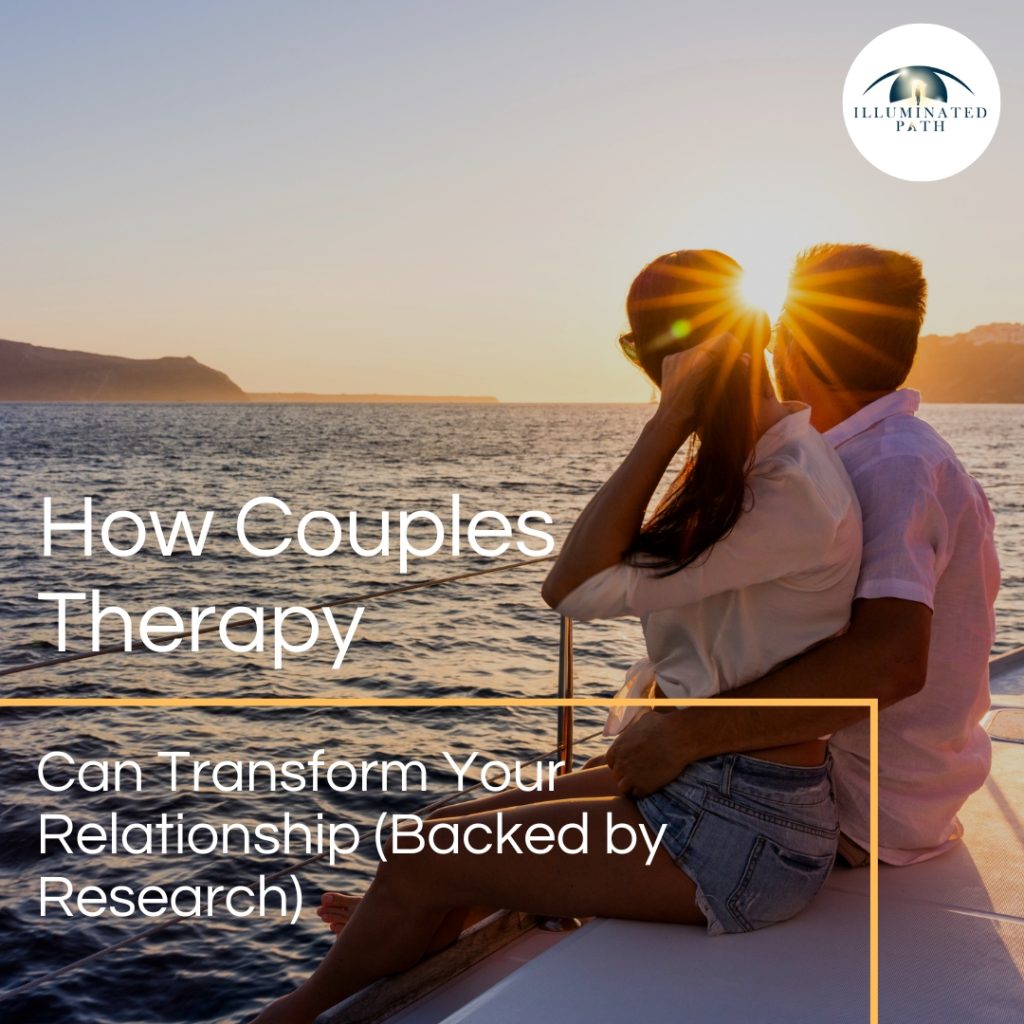
Relationships are at the heart of human experience, offering love, support, and companionship. They provide a sense of belonging, security, and shared joy. Yet, even the strongest bonds can face challenges. The ebb and flow of life, with its inevitable stressors, communication breakdowns, unresolved conflicts, and life transitions, can create distance and strain, leaving couples feeling disconnected and unfulfilled. But there’s hope. Research consistently demonstrates the effectiveness of couples therapy in helping couples navigate these challenges and build stronger, more fulfilling relationships. It offers a pathway to rekindle the flame, deepen connection, and rediscover the joy of partnership. Couples Therapy Effectiveness: By the Numbers The effectiveness of couples therapy is not just anecdotal; it’s backed by compelling data: 75% Improvement: Around 75% of couples who participate in couples therapy report an improvement in their relationship. (Source: American Association of Marriage and Family Therapists) This indicates that the majority of couples who invest in therapy experience positive changes in their relationship dynamics and overall satisfaction. They report feeling more connected, understood, and supported by their partners. Reduced Divorce Rates: Research indicates that couples therapy can significantly reduce divorce rates, with some studies showing a reduction of up to 50%. (Source: Journal of Marital and Family Therapy) This highlights the potential of therapy to not only improve relationships but also to help couples stay together. By providing tools for effective communication and conflict resolution, therapy can help couples navigate challenges and build a more resilient foundation for their relationship. Increased Emotional Well-being: 90% of couples who complete therapy with a highly trained couples therapist report an increase in their emotional well-being and more comfort in their relationship. (Source: American Association of Marriage and Family Therapists) This underscores the positive impact of therapy on individual emotional health within the context of the relationship. Couples learn to regulate their emotions, communicate their needs effectively, and create a more supportive and nurturing environment for each other. Greater Intimacy and Connection: A 2013 study in the Journal of Social and Personal Relationships found that couples who reported higher levels of vulnerability and self-disclosure during therapy also experienced greater intimacy and relationship satisfaction. This suggests that therapy can help couples create a safe space for vulnerability, leading to deeper connection and closeness. By sharing their fears, insecurities, and hopes with each other, couples can foster a greater sense of empathy and understanding. What Makes Couples Therapy So Effective? Couples therapy offers a unique and valuable space for couples to work through their challenges and build a stronger foundation for their relationship. Here are some key factors that contribute to its effectiveness: Structured Environment: Therapy provides a structured and supportive environment where couples can safely explore their concerns and work towards solutions. The therapist acts as a neutral facilitator, guiding the conversation and helping couples develop new ways of interacting. Skill-Building: Therapy equips couples with essential skills for a healthy relationship. This includes effective communication techniques, such as active listening, expressing needs clearly, and managing conflict constructively. Couples learn to identify and break free from negative patterns, replacing them with healthier habits of communication and interaction. Emotional Awareness: Therapy helps couples develop greater emotional awareness, both within themselves and in their partners. This involves understanding their own emotions, triggers, and attachment styles, as well as recognizing and responding to their partner’s emotional needs. Perspective Shifting: A skilled therapist can offer a fresh perspective on the relationship dynamics, helping couples see their patterns and challenges from a new angle. This can be invaluable in breaking free from entrenched perspectives and developing new ways of understanding each other. Vulnerability and Intimacy: Therapy creates a safe space for vulnerability, allowing couples to share their fears, insecurities, and hopes with each other. This fosters empathy, deepens connection, and strengthens the emotional bond between partners. Focus on Solutions: Therapy is not just about identifying problems; it’s about finding solutions and creating positive change. Therapists help couples develop concrete strategies and action plans to address their challenges and build a more fulfilling relationship. What Issues Can Couples Therapy Help With? Couples therapy can be beneficial for a wide range of challenges, including: Communication problems: Difficulty expressing needs, active listening, and understanding each other’s perspectives. Conflict resolution: Recurring arguments, difficulty finding compromise, and unhealthy conflict patterns. Intimacy and connection: Decreased intimacy, lack of emotional connection, and difficulties with physical intimacy. Trust and betrayal: Recovering from infidelity, rebuilding trust after a breach, and healing from past hurts. Life transitions: Navigating major life changes, such as having children, career shifts, or aging, with greater ease and support. Mental health concerns: Managing individual mental health challenges, such as anxiety or depression, and their impact on the relationship. Parenting differences: Navigating differences in parenting styles and finding common ground in raising children. Extended family issues: Managing relationships with in-laws and extended family members. Cultural or religious differences: Bridging cultural or religious differences and finding ways to honor each other’s values and beliefs. Don’t Wait for a Crisis: Many couples wait until their relationship is in serious trouble before seeking help. However, therapy can be even more effective as a preventative measure, strengthening your bond and equipping you with the skills to navigate challenges before they escalate. If you’re experiencing any difficulties in your relationship, consider couples therapy as an investment in your happiness and well-being. The research clearly shows that it can make a real difference in creating a more fulfilling and lasting partnership. Choosing the Right Therapist: Finding the right therapist is crucial for a successful therapy experience. Consider these factors when choosing a couples therapist: Qualifications and Experience: Look for a licensed therapist with specific training and experience in couples therapy. Therapeutic Approach: Explore different therapy modalities, such as Emotionally Focused Therapy (EFT), the Gottman Method, or Imago Relationship Therapy, to find one that resonates with you and your partner. Personality and Style: Choose a therapist with whom you both feel comfortable and who creates a safe and supportive
The Power of Vulnerability: Building Stronger Relationships Through Emotional Connection
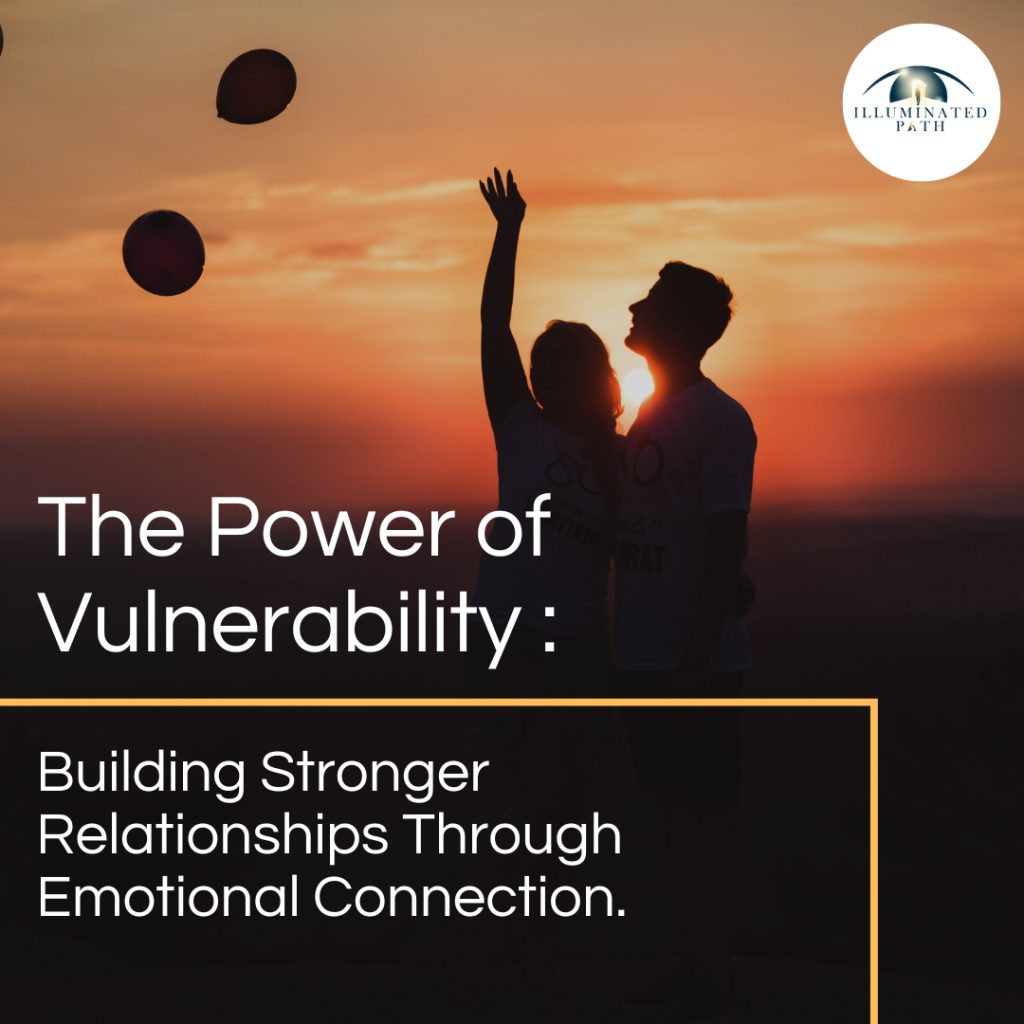
In a world that often prioritizes self-reliance and emotional stoicism, vulnerability can feel like a risky endeavor. We’re taught to project strength and independence, to keep our guards up and our emotions in check. But beneath the surface of this seemingly impenetrable armor lies a profound truth: vulnerability is not weakness, but the very key to unlocking deeper, more authentic connections with others. Vulnerability, in its essence, is the willingness to show up authentically, to let others see our true selves, imperfections and all. It’s about sharing our fears, our hopes, our dreams, and our scars, even when it feels scary. It’s about allowing ourselves to be seen, known, and loved for who we truly are, not for the carefully curated image we often present to the world. Why We Resist Vulnerability: The fear of vulnerability is deeply ingrained in many of us. We worry about being judged, rejected, or hurt. We fear that exposing our true selves will make us targets for criticism or ridicule. These fears often stem from past experiences of hurt or rejection, where vulnerability was met with insensitivity or betrayal. However, this fear of vulnerability can become a self-fulfilling prophecy. By closing ourselves off from others, we limit our ability to experience true connection and intimacy. We build walls around our hearts, preventing others from truly knowing and loving us. The Science of Connection: Research in social psychology and neuroscience has shed light on the profound importance of vulnerability in building strong, healthy relationships. Increased Intimacy and Connection: A 2013 study in the Journal of Social and Personal Relationships found that couples who reported higher levels of vulnerability and self-disclosure also experienced greater intimacy and relationship satisfaction. This suggests that when we allow ourselves to be seen and known by our partners, we create a deeper sense of connection and closeness. Enhanced Empathy and Understanding: Brené Brown’s research has shown that vulnerability is a key predictor of empathy and compassion. When we are willing to share our own struggles and vulnerabilities, we create a space for others to do the same, fostering a deeper understanding and connection (Brown, 2012). The Benefits of Embracing Vulnerability: The rewards of embracing vulnerability extend far beyond our interpersonal relationships. It can also lead to: Increased self-awareness: When we share our inner world with others, we gain a deeper understanding of ourselves and our emotions. Enhanced emotional resilience: By facing our fears and insecurities, we develop greater emotional resilience and the ability to cope with life’s challenges. Improved mental health: Studies have shown that vulnerability and self-compassion are associated with lower levels of anxiety, depression, and stress (Neff, 2003). Greater creativity and innovation: Vulnerability allows us to take risks, embrace new ideas, and think outside the box. Stronger leadership: Vulnerable leaders create a culture of trust and authenticity, inspiring others to be their best selves. Cultivating the Courage to Connect: Embracing vulnerability is not always easy. It requires courage, self-compassion, and a willingness to step outside our comfort zones. Here are some strategies to help you cultivate the courage to connect: Start small: Begin by sharing small vulnerabilities with trusted individuals. As you become more comfortable, you can gradually share deeper emotions and experiences. Practice self-compassion: Be kind and gentle with yourself, especially when you’re feeling vulnerable. Remember that it’s okay to make mistakes and that everyone experiences vulnerability. Challenge negative thoughts: Identify and challenge the negative thoughts that hold you back from being vulnerable. Replace self-critical thoughts with self-compassionate ones. Seek support: If you’re struggling with vulnerability, consider seeking support from a therapist or counselor. They can provide guidance and tools to help you overcome your fears and build stronger relationships. Cultivate a growth mindset: Embrace the belief that you can learn and grow from your experiences, even the challenging ones. This mindset can help you approach vulnerability with greater confidence and resilience. Vulnerability in Action: Real-Life Examples: The power of vulnerability can be seen in countless examples throughout history and in our everyday lives. Leaders who admit their mistakes, artists who bare their souls in their work, and friends who share their struggles with each other all demonstrate the transformative power of vulnerability. Consider the example of Brené Brown, a research professor who has spent years studying vulnerability, courage, and shame. In her TED Talk “The Power of Vulnerability,” Brown shares her own journey of embracing vulnerability and the profound impact it has had on her life and work. Her research and personal experiences have inspired millions to embrace their authentic selves and build deeper connections with others. The Ripple Effect of Vulnerability: When we choose vulnerability, we not only transform our own lives but also inspire others to do the same. Our willingness to be open and authentic creates a ripple effect, encouraging those around us to embrace their own vulnerabilities and build more meaningful connections. Imagine a world where vulnerability is celebrated, where we feel safe to share our true selves without fear of judgment or rejection. In such a world, empathy would flourish, compassion would abound, and our relationships would be deeper and more fulfilling. Conclusion: Vulnerability is not a sign of weakness; it’s a testament to our courage and our humanity. It’s the key to unlocking deeper connections, greater happiness, and a more meaningful life. By embracing our vulnerabilities, we open ourselves up to the transformative power of human connection. We create a world where authenticity is valued, empathy is nurtured, and love flourishes. So, dare to be vulnerable. Dare to connect. The rewards are immeasurable. Sources: Brown, B. (2012). Daring greatly: How the courage to be vulnerable transforms the way we live, love, parent, and lead. Gotham Books. Laurenceau, J. P., Barrett, L. F., & Pietromonaco, P. R. (1998). Intimacy as an interpersonal process: The importance of self-disclosure and perceived partner responsiveness in interpersonal exchanges. Journal of personality and social psychology, 74(5), 1238. Neff, K. D. (2003). Self-compassion: An alternative conceptualization of a healthy attitude toward oneself. Self and Identity, 2(4),
The Key to a Happy Relationship: It’s All About Repair, Not the Absence of Conflict
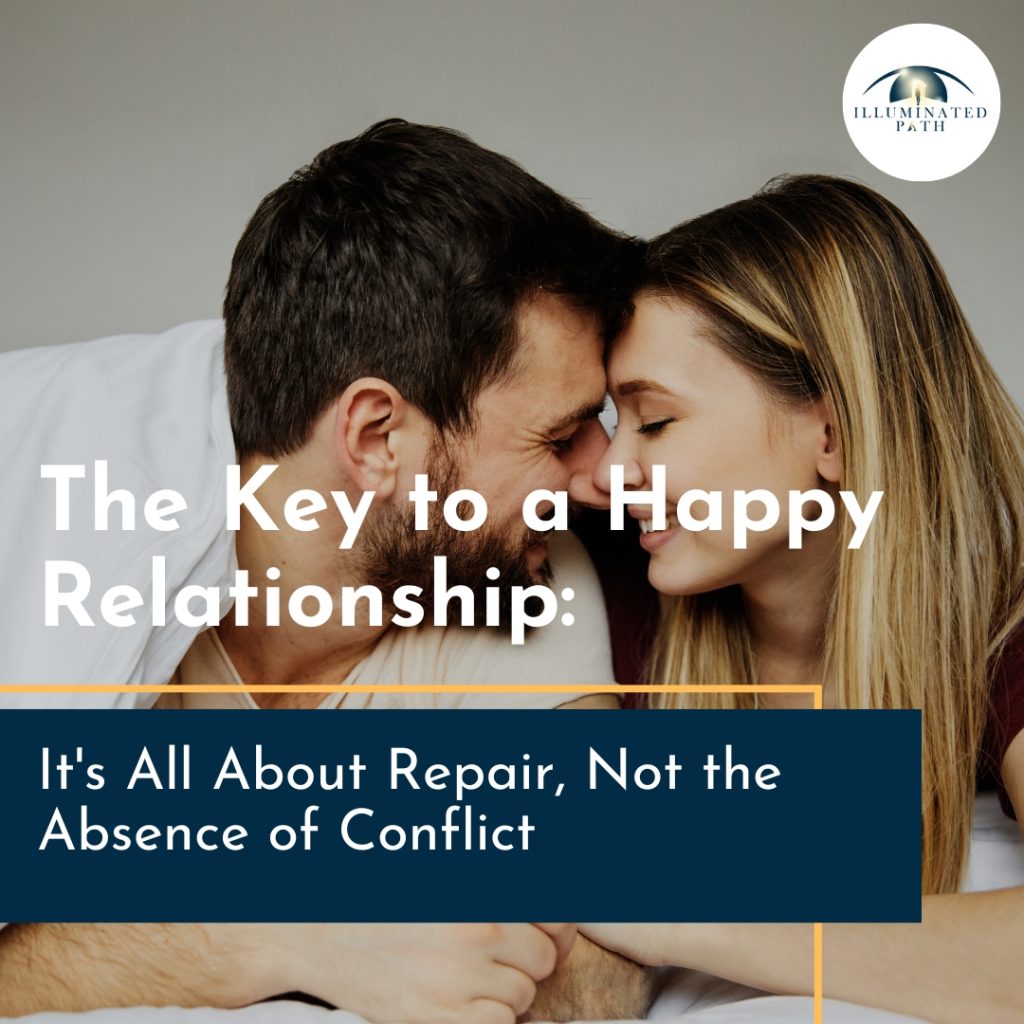
In the world of relationships, conflict is inevitable. Even the happiest couples argue, but what sets thriving relationships apart is how partners handle disagreements. John Gottman, a renowned psychologist and relationship expert, encapsulates this truth with his famous quote: “The key to a happy relationship is not the absence of conflict, but how you repair it.” This idea is more than just philosophical—research backs it up with compelling data. Gottman’s studies, conducted at the University of Washington, have shown that 69% of conflicts in relationships are perpetual problems, stemming from fundamental differences in personality, needs, or preferences. The real test of a relationship isn’t whether couples argue but whether they engage in repair attempts to resolve or manage these differences effectively. The Science of Repair Attempts Gottman’s research also revealed that couples who remain together happily over the long term excel in what he calls “repair attempts”—small actions or communications used to de-escalate tension and reconnect during or after a conflict. These repairs can be as simple as: Apologizing sincerely. Using humor to lighten the mood. Acknowledging the other person’s feelings. Suggesting a break to cool down before resuming the discussion. Couples who succeed in these repair attempts are significantly more likely to report high satisfaction in their relationships. According to Gottman, successful repair attempts predict relationship longevity with over 80% accuracy. Why Repair Matters More Than Harmony The misconception that happy couples never fight can create unrealistic expectations. The truth is that conflict can be healthy—it often signals areas where partners need to grow together. What matters is how couples use conflict to build understanding, intimacy, and trust. Repair attempts are a cornerstone of this process. Dr. Sue Johnson, the founder of Emotionally Focused Therapy, adds another layer to this insight:“Emotional bonds deepen when partners repair emotional injuries and reaffirm their commitment to each other.” This aligns perfectly with Gottman’s findings, emphasizing that the process of repair builds resilience in relationships. Practical Steps for Better Repair Attempts If you want to strengthen your relationship, consider these strategies: Pause and Reflect: Avoid letting emotions drive reactive responses during an argument. Take a moment to breathe and reflect on what your partner might be feeling. Express Vulnerability: A simple “I feel hurt because…” can open a dialogue rather than escalate conflict. Practice Active Listening: Repeat back what your partner says to show you understand, even if you disagree. Use Humor Sparingly: Laughter can be a great repair tool, but only if it feels respectful and well-timed. Revisit the Conflict: Not all issues can be resolved in the heat of the moment. Commit to discussing difficult topics later when both partners are calmer. Final Thoughts Conflict doesn’t have to be the enemy of a healthy relationship. When couples focus on repairing rather than avoiding disagreements, they create a stronger, more resilient bond. Gottman’s work reminds us that it’s not about perfection or harmony but about mutual effort and care. As you navigate your relationship, remember this truth: it’s not the absence of conflict but the presence of repair that determines your happiness together. By mastering repair attempts, you can turn conflict into a tool for connection and growth. The Author Dr. Shadi Souferian Psy. D. Licensed Clinical Psychologist Therapist And Psychologist in Los Angeles And Beverly Hills. You might also enjoy this article: The Key to a Happy Relationship: It’s All About Repair, Not the Absence of Conflict November 21, 2024By:Dr. Shadi Souferian, Psy.DRelationshipStress Management0Comments In the world of relationships, conflict is inevitable. Even the happiest couples argue, but what…Read more Finding Peace in the Present: Letting Go of “Should” and Managing Stress October 28, 2024By:Dr. Shadi Souferian, Psy.DPersonal DevelopmentStress Management0Comments our struggle to accept reality as it is often lies at the root of our…Read more Embracing Imperfection: A Path to Empathy and Acceptance October 17, 2024By:Dr. Shadi Souferian, Psy.DRelationshipCouple RelationshipMarriage0Comments Imperfection is a universal human experience. Yet, many of us strive for unattainable standards of…Read more Relationship Roadblocks? Your Attachment Style Might Be the Key October 10, 2024By:Dr. Shadi Souferian, Psy.DRelationshipCouple RelationshipMarriage0Comments Do you ever find yourself wondering why you react the way you do in relationships?…Read more Is Marriage Counseling Right for Us? Signs It Might Be Time to Seek Help October 4, 2024By:Dr. Shadi Souferian, Psy.DRelationshipCouple RelationshipMarriage0Comments Marriage, a journey filled with love, laughter, and shared dreams, can also be a rollercoaster…Read more Hidden Scars: Unmasking the Impact of Childhood Trauma October 2, 2024By:Dr. Shadi Souferian, Psy.DTraumaChildhoodTrauma0Comments The weight of childhood trauma settles on the soul like an invisible cloak, its presence…Read more
Embracing Imperfection: A Path to Empathy and Acceptance

Imperfection is a universal human experience. Yet, many of us strive for unattainable standards of perfection, leading to self-criticism, anxiety, and even social isolation. Recognizing and embracing our imperfections can be a transformative journey, fostering self-acceptance, empathy, and stronger relationships. This article will explore the benefits of embracing imperfection, drawing on research and personal anecdotes. The Prevalence of Perfectionism Perfectionism, the relentless pursuit of flawlessness, is a common trait. Studies have shown that a significant portion of the population grapples with perfectionistic tendencies. For instance, a study published in the Journal of Personality and Social Psychology found that over 50% of college students reported experiencing perfectionistic thoughts and behaviors. Source: Neff, K. D., & Morris, R. D. (2009). Self-compassion and perfectionism: A meta-analysis. Journal of Personality and Social Psychology, 97(1), 151-170. The Negative Impacts of Perfectionism Perfectionism can have detrimental effects on mental health and well-being. Research has linked perfectionism to higher rates of depression, anxiety, stress, and eating disorders. Additionally, perfectionists may struggle with procrastination, low self-esteem, and difficulty forming satisfying relationships. Source: Stoeber, J., & Frandsen, K. J. (2011). Perfectionism and mental health: A meta-analysis. Journal of Personality and Social Psychology, 101(3), 494-511. The Benefits of Embracing Imperfection Recognizing and accepting our imperfections can lead to numerous benefits, including: Increased self-acceptance: Embracing imperfection helps us to see ourselves as whole and complete, rather than as a collection of flaws. This can lead to increased self-esteem and a more positive body image. Reduced stress and anxiety: Perfectionism often involves excessive self-criticism and a constant fear of failure. By accepting our imperfections, we can reduce our stress and anxiety levels. Improved relationships: When we are more accepting of ourselves, we are also more likely to be accepting of others. This can lead to stronger, more fulfilling relationships. Enhanced creativity and innovation: Perfectionism can stifle creativity and innovation. By embracing imperfection, we can free ourselves from the fear of making mistakes and explore new ideas with greater confidence. How to Embrace Imperfection Embracing imperfection is a journey, not a destination. Here are some strategies to help you on your path: Practice self-compassion: Treat yourself with kindness and understanding, just as you would treat a friend. Challenge perfectionistic thoughts: When you find yourself thinking negatively about your imperfections, challenge those thoughts with evidence to the contrary. Set realistic goals: Instead of striving for perfection, set achievable goals that are aligned with your values and abilities. Celebrate your successes: Acknowledge and celebrate your accomplishments, no matter how small. Seek support: Connect with a life coach or support group for individuals working on self-acceptance and embracing imperfection. Sharing your experiences with others who understand your challenges can be a powerful source of support and inspiration. Case Study: The Journey of a Perfectionist To illustrate the transformative power of embracing imperfection, let’s consider the story of Sarah, a young woman who struggled with perfectionism for years. Sarah was constantly striving for perfection in her academic work, her relationships, and her appearance. This relentless pursuit of flawlessness led to significant stress, anxiety, and feelings of inadequacy. Sarah’s journey towards self-acceptance began with a conscious decision to challenge her perfectionistic thoughts. She started to notice how these thoughts often led to feelings of shame and self-doubt. Instead of believing these negative thoughts, Sarah began to question their validity and seek alternative perspectives. Over time, Sarah learned to practice self-compassion. She treated herself with kindness and understanding, recognizing that everyone makes mistakes and that it’s okay to be imperfect. She also began to set more realistic goals for herself, focusing on progress rather than perfection. As Sarah continued to embrace her imperfections, she experienced a significant reduction in stress and anxiety. She also found that her relationships with others became more fulfilling. By being more accepting of herself and others, Sarah was able to build stronger connections and create a more supportive social network. The Role of Mindfulness in Embracing Imperfection Mindfulness, the practice of paying attention to the present moment without judgment, can be a powerful tool for embracing imperfection. By cultivating mindfulness, we can become more aware of our thoughts and feelings, and learn to respond to them with greater compassion and acceptance. Several studies have demonstrated the benefits of mindfulness for individuals struggling with perfectionism. For example, a study published in the Journal of Cognitive Therapy and Research found that mindfulness-based interventions can help reduce perfectionistic thoughts and behaviors. Source: Baer, R. A., Smith, A. C., Lykins, M., & Allen, J. G. (2011). Mindfulness-based interventions for perfectionism: A review. Journal of Cognitive Therapy and Research, 35(1), 1-16. The Impact of Embracing Imperfection on Society Embracing imperfection can have a profound impact on society as a whole. When we are more accepting of our own imperfections, we are also more likely to be accepting of others. This can lead to a more compassionate and inclusive society, where everyone feels valued and respected. Additionally, embracing imperfection can inspire others to do the same. By sharing our own stories of vulnerability and self-acceptance, we can create a ripple effect of positive change. Conclusion Embracing imperfection is a journey that requires courage, self-compassion, and a willingness to let go of unrealistic expectations. By recognizing and accepting our flaws, we can experience increased self-esteem, reduced stress, improved relationships, and a greater sense of peace and fulfillment. As we continue to navigate the complexities of life, let us remember that it is okay to be imperfect. By embracing our imperfections, we can create a more compassionate, understanding, and authentic world for ourselves and others. Additional Considerations: The role of cultural influences on perfectionism: Different cultures may have varying expectations and attitudes towards perfection. Understanding these cultural differences can help us to appreciate the diversity of human experiences. The importance of self-care: Embracing imperfection often involves taking care of ourselves both physically and emotionally. This may include engaging in activities that promote relaxation, well-being, and personal growth. The connection between embracing imperfection and social justice: By challenging perfectionistic norms, we can
Relationship Roadblocks? Your Attachment Style Might Be the Key

Do you ever find yourself wondering why you react the way you do in relationships? Or maybe why your partner seems to have a completely different approach to intimacy and connection? The answer might lie in your attachment styles. Attachment theory, developed by John Bowlby and Mary Ainsworth, suggests that our early childhood experiences with caregivers shape the way we form bonds with others in adulthood. These patterns of behavior are known as attachment styles. The Four Attachment Styles: Secure: Individuals with a secure attachment style feel comfortable with intimacy and independence. They are able to express their needs and emotions openly, and they trust their partners. Anxious-Preoccupied: Those with an anxious-preoccupied attachment style crave intimacy and fear abandonment. They may become overly dependent on their partners and seek constant reassurance. Dismissive-Avoidant: People with a dismissive-avoidant attachment style value independence and tend to suppress their emotions. They may avoid intimacy and have difficulty committing to relationships. Fearful-Avoidant: Individuals with a fearful-avoidant attachment style desire intimacy but fear getting hurt. They may have a history of trauma or abuse, which makes it difficult for them to trust others. How Attachment Styles Impact Relationships: Your attachment style can significantly influence your relationship dynamics. For example: Communication: Securely attached individuals are generally good communicators, while those with insecure attachment styles may struggle to express their needs or understand their partner’s perspective. Conflict resolution: Secure partners tend to approach conflict constructively, while insecure partners may become defensive or withdraw. Intimacy: Secure individuals are comfortable with intimacy, while those with insecure attachment styles may have difficulty with closeness or vulnerability. Discovering Your Attachment Style: Reflecting on your past relationships and current behaviors can provide clues about your attachment style. You can also take online quizzes or seek professional guidance from a couple and relationship therapist. Improving Your Relationships: Understanding your attachment style and your partner’s can be a game-changer for your relationship. It can help you: Increase self-awareness: Recognize your own patterns and triggers. Improve communication: Learn to express your needs and understand your partner’s perspective. Develop empathy: Appreciate the challenges your partner may be facing based on their attachment style. Build trust: Create a safe and secure space for emotional connection. By understanding your attachment style and its impact on your relationships, you can unlock the key to deeper connection and lasting love. This journey of self-discovery might not always be easy. It requires introspection, courage, and a willingness to confront past hurts and ingrained patterns. But the rewards are immeasurable. As you gain a deeper understanding of yourself and your partner, you’ll be equipped to navigate challenges with greater empathy and compassion. You’ll learn to communicate more effectively, build stronger bonds of trust, and cultivate a love that is truly secure and fulfilling. Remember, personal growth is an ongoing process, and every step you take towards secure attachment brings you closer to experiencing the loving, fulfilling relationships you deserve. So, embrace this journey of self-discovery and watch your relationships blossom in ways you never thought possible. The Author Dr. Shadi Souferian Psy. D. Licensed Clinical Psychologist Therapist And Psychologist in Los Angeles And Beverly Hills. You might also enjoy this article: Relationship Roadblocks? Your Attachment Style Might Be the Key October 10, 2024By:Dr. Shadi Souferian, Psy.DRelationshipCouple RelationshipMarriage0Comments Do you ever find yourself wondering why you react the way you do in relationships?…Read more Is Marriage Counseling Right for Us? Signs It Might Be Time to Seek Help October 4, 2024By:Dr. Shadi Souferian, Psy.DRelationshipCouple RelationshipMarriage0Comments Marriage, a journey filled with love, laughter, and shared dreams, can also be a rollercoaster…Read more Hidden Scars: Unmasking the Impact of Childhood Trauma October 2, 2024By:Dr. Shadi Souferian, Psy.DTraumaChildhoodTrauma0Comments The weight of childhood trauma settles on the soul like an invisible cloak, its presence…Read more Finding Meaning in Life’s Transformations: Embracing Change with the Help of Psychology September 25, 2024By:Dr. Shadi Souferian, Psy.DLife TransformationLifetransition0Comments Life is a symphony composed with notes of joy, sorrow, triumph, and challenge. It’s a…Read more Anxiety and Relationships: Communication and Understanding – The Statistical Picture September 19, 2024By:Dr. Shadi Souferian, Psy.DRelationship0Comments Anxiety disorders, with their pervasive reach, impact a significant portion of the population, casting a…Read more How Couples Therapy Can Strengthen Your Bond: A Path to Lasting Love September 18, 2024By:Dr. Shadi Souferian, Psy.DRelationship0Comments Maintaining a fulfilling and harmonious relationship requires ongoing effort and dedication. Even the most devoted…Read more
Is Marriage Counseling Right for Us? Signs It Might Be Time to Seek Help

Marriage, a journey filled with love, laughter, and shared dreams, can also be a rollercoaster ride of challenges, disagreements, and unexpected hurdles. While every couple faces bumps along the road, sometimes those bumps become mountains, leaving you feeling lost, disconnected, and unsure of how to navigate the path forward. If you find yourself relating to this, you’re not alone. Many couples reach a point where they wonder, “Is marriage counseling right for us?” This article delves into the benefits of marriage counseling, explores common reasons couples seek help, and offers a checklist of red flags that indicate professional support could be beneficial. The Power of Professional Guidance Marriage counseling, also known as couples therapy, provides a safe and supportive space for couples to address challenges, improve communication, and strengthen their bond. Think of it as a tune-up for your relationship, guided by a trained professional who can offer objective insights and evidence-based tools. Here’s how marriage counseling can help: Improved Communication: A skilled therapist can help you identify communication patterns that are hindering your relationship and teach you healthier ways to express your needs and resolve conflicts. Increased Empathy and Understanding: Counseling fosters a deeper understanding of each other’s perspectives, emotions, and underlying needs, leading to increased empathy and compassion. Rebuilding Trust: If trust has been broken due to infidelity, betrayal, or other issues, therapy can provide a framework for rebuilding trust through honesty, accountability, and forgiveness. Conflict Resolution Skills: Learn effective strategies for managing disagreements constructively, finding common ground, and reaching mutually satisfying solutions. Rekindling Intimacy: Therapy can help you address issues that are affecting your emotional and physical intimacy, reigniting the spark and deepening your connection. Navigating Life Transitions: Whether it’s adjusting to parenthood, dealing with a career change, or coping with aging parents, counseling can provide support and guidance during significant life transitions. But does marriage counseling work? Research suggests that it can be highly effective. A study published in the Journal of Consulting and Clinical Psychology found that 70% of couples who participated in marriage counseling reported significant improvements in their relationship satisfaction. (Baucom, D. H., Shoham, V., Mueser, K. T., Daiuto, A. D., & Stickle, T. R. (1998). Empirically supported couple and family interventions for marital distress and adult mental health problems. Journal of Consulting and Clinical Psychology, 66(1), 53-88.) Why Do Couples Seek Marriage Counseling? Couples seek counseling for a wide range of reasons, and there’s no “one size fits all” answer. Here are some of the most common issues that bring couples to therapy: Communication Problems: Difficulty expressing needs, constant arguing, feeling unheard or misunderstood. Infidelity: Dealing with the aftermath of an affair, rebuilding trust, and addressing underlying issues. Loss of Intimacy: Decreased emotional and/or physical connection, lack of affection, feeling distant. Financial Stress: Disagreements about money management, differing financial goals, financial infidelity. Parenting Conflicts: Differing parenting styles, disagreements about discipline, challenges with blended families. Life Transitions: Adjusting to major life changes such as marriage, parenthood, empty nest, retirement, or illness. Mental Health Concerns: Dealing with depression, anxiety, trauma, or other mental health challenges that are impacting the relationship. Substance Abuse: Addressing the impact of addiction on the relationship and supporting recovery. It’s important to remember that seeking help is a sign of strength, not weakness. It shows a commitment to your relationship and a willingness to invest in its future. Red Flags: Is it Time to Consider Counseling? While every relationship has its ups and downs, certain warning signs may indicate that professional help is needed. Here’s a checklist of red flags to consider: Communication and Conflict: Constant Arguing: Frequent disagreements that escalate quickly and rarely reach a resolution. Stonewalling or Withdrawal: One or both partners shut down during conflict, refusing to communicate or engage. Criticism and Contempt: Regularly expressing criticism, sarcasm, or hostility towards each other. Defensiveness: Inability to take responsibility for actions or acknowledge the other person’s perspective. Emotional Connection: Feeling Distant and Disconnected: Lack of emotional intimacy, feeling like roommates rather than partners. Loss of Affection: Decreased physical touch, lack of intimacy, and expressions of love. Lack of Trust: Suspicion, jealousy, or difficulty believing each other. Feeling Lonely in the Relationship: Experiencing a sense of isolation and lack of support from your partner. Behavioral Patterns: Considering or Threatening Separation/Divorce: Frequently discussing or thinking about ending the relationship. Infidelity (Emotional or Physical): Engaging in intimate relationships outside of the marriage. Substance Abuse: Using drugs or alcohol to cope with relationship problems. Domestic Violence (Physical, Emotional, or Verbal): Any form of abuse is unacceptable and requires immediate professional intervention. If you recognize several of these red flags in your relationship, it’s crucial to seek help sooner rather than later. The longer issues fester, the more difficult they can be to address. Taking the First Step Deciding to pursue marriage counseling can be a significant step, but it doesn’t have to be overwhelming. Here are some tips for getting started: Talk to your partner: Openly and honestly discuss your concerns and why you think counseling might be helpful. Find a qualified therapist: Look for a licensed marriage and family therapist (LMFT) with experience in addressing your specific concerns. Be prepared to invest time and effort: Counseling requires commitment and active participation from both partners. Approach therapy with an open mind: Be willing to be vulnerable, honest, and open to new perspectives. Remember, seeking help is a sign of strength and a commitment to your relationship. With the right support and guidance, you can navigate challenges, strengthen your bond, and create a more fulfilling future together. The Author Dr. Shadi Souferian Psy. D. Licensed Clinical Psychologist Therapist And Psychologist in Los Angeles And Beverly Hills. You might also enjoy this article: Hidden Scars: Unmasking the Impact of Childhood Trauma – Copy October 4, 2024By:RyoTraumaChildhoodTrauma0Comments Marriage, a journey filled with love, laughter, and shared dreams, can also be a rollercoaster…Read more Hidden Scars: Unmasking the Impact of Childhood Trauma October 2, 2024By:Dr. Shadi Souferian, Psy.DTraumaChildhoodTrauma0Comments The weight of childhood trauma settles
